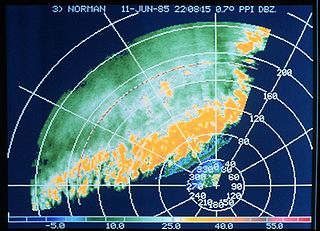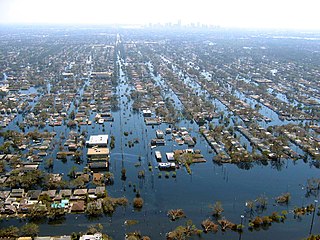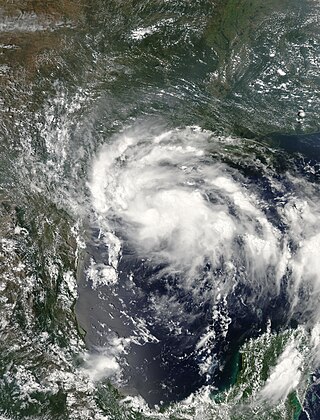Related Research Articles

Pineapple Express is a non-technical term for a meteorological phenomenon, a specific recurring atmospheric river characterized by a strong and persistent large-scale flow of warm moist air, and the associated heavy precipitation both in the waters immediately northeast of the Hawaiian Islands and extending northeast to any location along the Pacific coast of North America. A Pineapple Express is an example of an atmospheric river, which is a more general term for such relatively narrow corridors of enhanced water vapor transport at mid-latitudes around the world.

A rainband is a cloud and precipitation structure associated with an area of rainfall which is significantly elongated. Rainbands can be stratiform or convective, and are generated by differences in temperature. When noted on weather radar imagery, this precipitation elongation is referred to as banded structure. Rainbands within tropical cyclones are curved in orientation. Rainbands of tropical cyclones contain showers and thunderstorms that, together with the eyewall and the eye, constitute a hurricane or tropical storm. The extent of rainbands around a tropical cyclone can help determine the cyclone's intensity.

Tropical Storm Frances caused extensive flooding in Mexico and Texas in September 1998. The sixth tropical cyclone and sixth named storm of the annual hurricane season, Frances developed from a low pressure area in the Gulf of Mexico on September 8. The cyclone moved northward through the western Gulf of Mexico, making landfall across the central Texas coastline before recurving across the Midwest through southeast Canada and New England. A large tropical cyclone for the Atlantic basin, yet an average sized system by western Pacific standards, the storm produced heavy rains across the Isthmus of Tehuantepec, Texas, western Louisiana and the Great Plains.
Floods in the United States are generally caused by excessive rainfall, excessive snowmelt, and dam failure. Below is a list of flood events that were of significant impact to the country during the 20th century, from 1900 through 1999, inclusive.

The characteristics of United States rainfall climatology differ significantly across the United States and those under United States sovereignty. Late summer and fall tropical cyclones bring precipitation which falls across the Gulf and Atlantic states. During the winter, and spring, Pacific storm systems bring Hawaii and the western United States most of their precipitation. Low pressure systems moving up the East coast bring cold season precipitation to the Mid-West and Northeast states, as well as Great Salt Lake and the Finger Lakes region. The snow to liquid ratio across the contiguous United States averages 13:1, meaning 13 inches (330 mm) of snow melts down to 1 inch (25 mm) of water.

Floods in the United States (2000–present) is a list of flood events which were of significant impact to the country during the 21st century, since 2000. Floods are generally caused by excessive rainfall, excessive snowmelt, storm surge from hurricanes, and dam failure.
The 2007 Midwest flooding was a major flooding event that occurred in the Midwestern United States in the third week of August 2007. While Hurricane Dean was affecting the Yucatán Peninsula and the Gulf of Mexico, and Tropical Storm Erin was affecting Oklahoma and Texas, a persistent storm system hung over the Midwest for several days, causing repeated flash flooding in the US states of Illinois, Indiana, Iowa, Minnesota, Ohio, and Wisconsin. Cool Canadian air clashed with large quantities of warm moist air from the Gulf, producing torrential rains along a stationary front. 5 deaths across the central United States were attributed to the resulting flooding. Seven Minnesota counties, eight Ohio counties, fourteen counties in Wisconsin, and seven counties in Illinois were declared Federal Disaster Areas.

Tropical Storm Erin was a minimal tropical storm that made landfall in Texas in August 2007. The storm's remnants also unexpectedly restrengthened over Oklahoma, causing damage there as well. The second tropical cyclone to make landfall in the United States in the 2007 Atlantic hurricane season and the fifth named storm of the year, Erin formed in the Gulf of Mexico on August 14 from a persistent area of convection. It attained tropical storm status the next day, and on August 16, 2007, Erin made landfall near Lamar, Texas, and persisted over land across Texas before moving northward into Oklahoma. Due to the brown ocean effect, Erin intensified after landfall. The storm resulted in sixteen fatalities and worsened an already-severe flooding issue in Texas.

The Mid-December 2007 North American winter storms were a series of two winter storms that affected much of central and eastern North America, from December 8 to December 18, 2007. The systems affected areas from Oklahoma to Newfoundland and Labrador with freezing rain, thunderstorms, sleet, snow, damaging winds, and blizzard-like conditions in various areas. The first two storms produced copious amounts of ice across the Midwestern United States and Great Plains from December 8 to December 11, knocking out power to approximately 1.5 million customers from Oklahoma north to Iowa. The second storm moved northeast, producing heavy snow across New York and New England. A third storm was responsible for a major winter storm from Kansas to the Canadian Maritimes, bringing locally record-breaking snowfalls to Ontario, an icestorm across the Appalachians, and thunderstorms and tornadoes to the Southeastern United States.

The climate of the United States varies due to changes in latitude, and a range of geographic features, including mountains and deserts. Generally, on the mainland, the climate of the U.S. becomes warmer the further south one travels, and drier the further west, until one reaches the West Coast.

The October 1998 Texas Flooding was a flood event that occurred across parts of South Texas and Southeast Texas on the weekend of October 17 and October 18, 1998. The storm that caused it was one of the costliest in the recorded meteorological history of the United States, bringing rainfall of over 20 inches (510 mm) to some parts of Southeast Texas and causing over $ 1.19 billion in damages. 31 people were killed as a result of the storm, mostly from drowning.
The March 2010 nor'easter or St. Patrick's Day nor'easter was a powerful nor'easter that impacted the Northeastern United States and Eastern Canada from March 12–16, 2010, resulting in at least nine deaths. The slow-moving storm produced over 10 inches (25 cm) of rain in New England, causing widespread flooding of urban and low-lying areas. Winds of up to 70 miles per hour (110 km/h) snapped trees and power lines, resulting in over one million homes and businesses left without electricity. The storm also caused extensive coastal flooding and beach erosion. The nor'easter was the fifth major winter storm to impact the Mid-Atlantic and New England in the 2009–10 North American winter storm season.
Global weather activity of 2007 profiles the major worldwide weather events, including blizzards, ice storms, tornadoes, tropical cyclones, and other weather events, from January 1, 2007, to December 31, 2007. Winter storms are events in which the dominant varieties of precipitation are forms that only occur at cold temperatures, such as snow or sleet, or a rainstorm where ground temperatures are cold enough to allow ice to form. It may be marked by strong wind, thunder and lightning, heavy precipitation, such as ice, or wind transporting some substance through the atmosphere. Other major non winter events such as large dust storms, Hurricanes, cyclones, tornados, gales, flooding and rainstorms are also caused by such phenomena to a lesser or greater existent.
September 2010 flash flooding in Minnesota and Wisconsin put towns underwater and forced evacuations in southern Minnesota and central Wisconsin. A strong system caused the heavy rain and flash flooding in the Upper Midwest.

Hurricane Norma was one of the two hurricanes to make landfall during the 1981 Pacific hurricane season. It developed on October 8, strengthening into a tropical storm and later a hurricane. Norma moved slowly to the northwest and strengthened into a Category 3 hurricane on the Saffir–Simpson hurricane scale. The storm recurved and accelerated to the northeast on October 11 and weakened to a Category 2. The next day, Norma made landfall near Mazatlán on October 12 and soon dissipated. The hurricane's remnants continued northeastward and entered the United States, crossing into central Texas before being absorbed by a frontal system on October 14. Norma caused $24 million in crop damage and one death in Mexico, as well as up to 10 in (250 mm). In Texas, the storm produced flooding rains that killed five people, $50 million in damage and caused many tornadoes. Rainfall was also reported as far inland as Kansas.

Preceded by more than a week of heavy rain, a slow-moving storm system dropped tremendous precipitation across much of Texas and Oklahoma during the nights of May 24–26, 2015, triggering record-breaking floods. Additionally, many areas reported tornado activity and lightning. Particularly hard hit were areas along the Blanco River in Hays County, Texas, where entire blocks of homes were leveled. On the morning of May 26, the National Weather Service issued a flash flood emergency for southwest Harris County and northeast Fort Bend County. The system also produced deadly tornadoes in parts of Mexico, Texas, and Oklahoma. This flood significantly contributed to the wettest month ever for Texas and Oklahoma.

The December 2015 North American storm complex, also known as Winter Storm Goliath, was a major storm complex that produced a tornado outbreak, a winter storm, a blizzard and an ice storm in areas ranging from the Southwestern United States to New England. Tornadoes impacted areas around Dallas, Texas while several other states, especially Missouri, were affected by heavy rain and snow causing severe floods. As the system moved through the Great Lakes region, heavy rain, ice pellets and heavy snow fell in the entire region. Wintry mix moved through southern Ontario and Quebec had significant snowfall on December 29. Almost 60 people were killed in the storm system and its aftermath, which made it one of the deadliest of such systems of 2015 in the United States.

Between May and June 2019, an extended sequence of heavy rainfall events over the South Central United States caused historic flooding along the Arkansas River and its tributaries. Major and record river flooding occurred primarily in northeastern Oklahoma, and the elevated flows continued downstream into Arkansas where they caused additional inundation. Antecedent soil moisture levels and water levels in lakes and streams were already high from previous rains, priming the region for significant runoff and flooding. The prolonged combination of high atmospheric moisture and a sustained weather pattern extending across the continental United States led to frequent high-yield rainfall over the Arkansas River watershed. The overarching weather pattern allowed moisture levels to quickly rebound after each sequential rainfall episode. With soils already saturated, the excess precipitation became surface runoff and flowed into the already elevated lakes and streams. Most rainfall occurred in connection with a series of repeated thunderstorms between May 19–21, which was then followed by additional rains that kept streams within flood stage.

In May 2021, prolonged rainfall from a series of weather disturbances affected the South Central United States, namely Texas and Louisiana. As a result of rainfall totals, which peaked at 17.16 in (436 mm) in Fannett, Texas, widespread flash flooding occurred. Outside those states, Kansas saw up to 8.16 inches (20.7 cm) of rain, and 70 miles per hour (110 km/h) wind gusts, while New Mexico recorded a 69 miles per hour (111 km/h) wind gust.
References
- ↑ "Flood-Ravaged Texas Gets More Rain After Storms Claim 11 Lives | Fox News". Fox News. 2007-06-28. Retrieved 2016-04-26.
- ↑ "Floods in Texas and Oklahoma : Natural Hazards". earthobservatory.nasa.gov. 2007-06-20. Retrieved 2016-04-26.
- ↑ (PDF) http://hydromet.lcra.org/riverreport/Documents/2007_Flood_Report.pdf.
{{cite web}}: Missing or empty|title=(help) - ↑ "Flood-Ravaged Texas Gets More Rain After Storms Claim 11 Lives | Fox News". Fox News. 2007-06-28. Retrieved 2016-04-26.